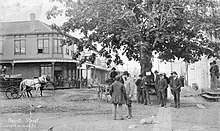Great Vancouver Fire
[1] The first fire was farther away from the city and was clearing land for the roundhouse of the terminus of the Canadian Pacific Railway.
[1] The Great Fire occurred shortly after the township of Granville had been incorporated into the City of Vancouver in April 1886.
[1] The fires spread northeast into the city, killing at least 21 people [2] and destroying 600 to 1,000 buildings (the exact numbers are unknown).
[1] The city's first police force was set up, its first brick buildings were built, and its first fire engine was brought in from the nearby larger town of New Westminster.
[1] European settlement in the Vancouver area began in 1862 after Captain George Henry Richard's 1859 discovery of coal in the Burrard Inlet.
[3] The exact numbers are unknown as many of the workers were transient unmarried men, who worked at a mill for only a few weeks at a time before moving on.
[1] Early Vancouver attracted budding entrepreneurs[6] who were very active in the civic politics forming the new city.
[1] The dry conditions and a Pacific breeze caused the fire to grow out of workers' control throughout the morning and into the afternoon.
[1] The second clearing fire was located at the west end of the city near the intersection of Cambie and Cordova street.
[1] The Squamish people from the south shore village Snauq, paddled across in canoes to view the fire.
[9] The men of the Vancouver Volunteer Hose Company No.1 went to Scoullar's General Store to remove a supply of explosives, which were taken to the Hastings Mill at the opposite end of town.
[1] The telegram to the Prime Minister Sir John A. Macdonald read: "Our city is ashes three thousand people homeless can you send us any government aid?
[2] The exact number of dead is unknown, mostly because Vancouver's population at this time was constantly changing due to its rapid expansion as well as the transient nature of many of the mill workers.
[10] The Day in New London, Connecticut, reported the fire June 15, 1886, with 50 people dead, 1,000 homeless and a total loss of one million dollars.
[11] The Manistee Weekly Times in the June 15, 1886, edition outlined the events of the fire and attributed the blaze to the Canadian Pacific Railway.
[13] It reported 12 lives had been lost, outlined the events of the fire and included a response from the Toronto mayor promising immediate aid.
[13] The Montreal Gazette reported June 18, 1938, that a George H. Keefer of Cobble Hill, B.C., claimed he was responsible for setting the Great Vancouver Fire.
[1] The day after the fire, to address looting, Mayor MacLean appointed three special constables, Jackson Abray, V.W.
[1] In the days that followed, the residents of Vancouver set up white canvas tents and small huts[4] and searched the wreckages of their homes and businesses looking for any surviving objects.
[4] Within two weeks, Cordova St from Carrall to Abbott streets was filled with businesses reopening in basic structures.






